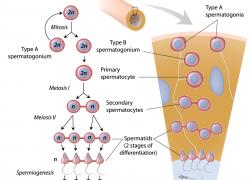French Lab Announces It Has Created Human Sperm
Scientists from the biotech company Kallistem, in Lyon, France, announced last month that they had produced human spermatozoa (i.e. swimming sperm) in-vitro, though, so far, their research has not been published in a scientific journal.

They produced the spermatozoa using testicular biopsies containing only a few immature germ cells, or spermatogonia . Spermatogonia are cells with a complete set of hereditary material, i.e., 46 chromosomes, and are already present in the testicles of a male fetus. Naturally, these cells undergo a process called meiosis , cellular division in which the number of chromosomes is reduced to 23, so that during fertilization, they can fuse with the 23 chromosomes of the female egg and produce a healthy zygote with 46 chromosomes (a new, unique, human individual).
The researchers claim that their process could help infertile men who suffer from obstructive azoospermia, a defect in the process of sperm production. The company calculates that the process could generate profits of €2.3 billion ($2.6 billion).
Professor Israël Nisand, cofounder of the European Forum on Bioethics, told Le Figaro that in-vitro production of sperm would be better than reproductive cloning. Other experts have greeted the news with caution, and rightfully so. For whether or not an advance is better is not simply a question of better technique as they pose, but a question of medical ethics as well.
Biological Data
Spermatogonia have two primary functions:
- Spermatogenesis, or the process by which spermatozoa are formed, is begun in the spermatogonia stage;
- and Spermatogonia increase significantly the population of germ cells via mitosis, i.e. cellular division in which the number of chromosomes is maintained at 46, before beginning the reductive process of meiosis. Spermatogonia undergo mitosis on average eight or nine times before meiosis begins. Thus, a single spermatogonia can produce 2,048 to 4,096 spermatozoa, depending on the number of mitosis divisions.
Ethical Analysis
-
Creating spermatozoa in the laboratory (artificial spermatogenesis) is a genetic manipulation of gametes with a number of possible consequences:
- During meiosis, numeric alterations of the chromosomes can occur (trisomies or monosomies) as can structural alterations (deletions, insertions, inversions). If conception occurs, these abnormal gametes can result in babies with chromosomal illnesses (such as trisomy 21, Cri-du-chat syndrome, and others), which most often lead to the death of a human life through the destruction of the embryo or selective abortions.
- Genetic manipulation can produce mutations that bring about genetic illnesses;
- With in-vitro spermatogenesis, effects on future children or their descendants cannot be foreseen; and
- The manipulation of gametes could open the door to eugenics through the selection of certain biological characteristics when creating the spermatozoa in the lab.
-
The production of spermatozoa in the lab implies that they will be used in processes of artificial insemination or in-vitro fertilization, which have their own ethical implications:
- Would the man from whom spermatogonia is taken know of the donation? It is possible spermatogonia could be used postmortem or in heterologous (across subjects of other biological origin) processes;
- Creating spermatozoa in the lab could open up the possibility of attempting to produce gametes from somatic cells , mature cells from other tissues of the body, such as skin. Such production could lead to the possibility of attempting to form an embryo from the union of two sperm or two ova.
Professor Nisand's statement that it is better to produce spermatozoa in-vitro than to use reproductive cloning is not a correct application of the principle of choosing the lesser evil, which demands that the lesser evil be permitted only where both evils are unavoidable . That is not the case here since both processes are avoidable.
It's noteworthy that the diagnosis they are attempting to address with this research was indicated as obstructive azoospermia, a condition wherein spermatozoa are produced in the testicles, but cannot exit . Solving this problem does not require that spermatozoa be created in-vitro. Technically, though not ethically, the spermatozoa could just be removed directly from the testicle and used in artificial insemination. So, if the process proposed is not necessary to resolve the stated problem, why create sperm in the lab? Perhaps the answer lies somewhere in those billions of dollars in projected profits.
The production of spermatozoa in the laboratory does not assist the process of procreation, but is yet another step in the techniques of artificial reproduction which serve to bypass procreation altogether and deny necessary attention to actual therapy. It serves to advance the ideology of producing human beings at any cost, of believing that children are rights to be had, rather than most welcome gifts, bestowed in the context of spousal love and self-giving.
Article copyrights are held solely by author.
[ Japan-Lifeissues.net ] [ OMI Japan/Korea ]